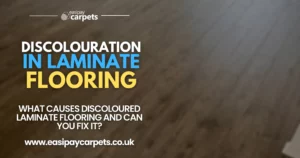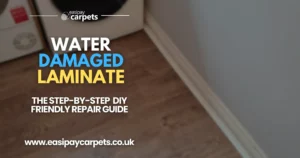

How To Deal With Laminate Flooring End Gaps
Laminate flooring is a popular choice for its durability, affordability, and aesthetic appeal, but sometimes end gaps can appear between the planks. These gaps can be unsightly and potentially damaging if left unaddressed. Don’t worry – we’ve got the solutions you need to fix those pesky gaps and prevent them from happening in the future. Let’s dive in!
Understanding Laminate Flooring End Gaps
What are End Gaps?
End gaps are the spaces that appear between the ends of laminate flooring planks. These gaps can occur for several reasons, including:
- Improper Installation: Incorrect installation techniques can lead to gaps.
- Temperature and Humidity Changes: Laminate flooring expands and contracts with changes in temperature and humidity, potentially causing gaps.
- Subfloor Issues: An uneven or improperly prepared subfloor can cause planks to shift and create gaps.
- Wear and Tear: Over time, regular use and movement can cause planks to separate.
Causes of Laminate Flooring End Gaps
1. Improper Installation
Cause:
Gaps can occur if the planks were not installed correctly, such as not leaving enough expansion gaps around the perimeter or not locking the planks together properly.
Solution:
- Professional Installation: Ensure that the flooring is installed by a professional or follow manufacturer guidelines carefully if DIY.
- Expansion Gaps: Always leave the recommended expansion gaps around the room’s edges to accommodate natural movement.
2. Temperature and Humidity Changes
Cause:
Laminate flooring can expand and contract with fluctuations in temperature and humidity, leading to gaps.
Solution:
- Climate Control: Maintain a consistent indoor climate using heating and cooling systems to minimize fluctuations.
- Acclimation: Allow the flooring to acclimate to the room’s temperature and humidity for at least 48 hours before installation.
3. Subfloor Issues
Cause:
An uneven or improperly prepared subfloor can cause laminate planks to shift and create gaps.
Solution:
- Subfloor Preparation: Ensure the subfloor is clean, dry, and level before installation. Use a levelling compound if necessary.
- Underlayment: Use a high-quality underlayment to provide a smooth, even surface for the laminate flooring.
4. Wear and Tear
Cause:
Regular use and movement over time can cause planks to separate and create gaps.
Solution:
- Regular Maintenance: Perform regular inspections and maintenance to identify and address issues early.
- Proper Footwear: Encourage the use of soft-soled shoes or slippers to reduce wear and tear on the flooring.
How to Fix Laminate Flooring End Gaps
1. Using a Floor Gap Fixer Tool
A floor gap fixer tool, often called a “floor gap tool” or “pull bar,” is designed to help close gaps between laminate planks.
Steps:
- Clean the Area: Ensure the area around the gap is clean and free of debris.
- Place the Tool: Position the floor gap tool against the plank with the gap.
- Apply Pressure: Tap the tool gently with a mallet to slide the plank back into place. Be careful not to damage the plank.
- Check for Alignment: Ensure the plank is properly aligned with the adjacent planks.
2. Using Wood Glue
For more permanent fixes, wood glue can be used to secure the planks together.
Steps:
- Clean the Area: Ensure the area around the gap is clean and free of debris.
- Apply Glue: Apply a small amount of wood glue to the gap between the planks.
- Close the Gap: Use a floor gap tool or gently tap the planks with a mallet to close the gap.
- Wipe Excess Glue: Wipe away any excess glue with a damp cloth.
- Let it Dry: Allow the glue to dry completely before walking on the floor.
3. Using Adhesive Strips
Adhesive strips can be used to secure the planks together and prevent them from separating again.
Steps:
- Clean the Area: Ensure the area around the gap is clean and free of debris.
- Apply Adhesive Strips: Place adhesive strips along the edges of the planks where the gap has appeared.
- Press and Hold: Press the planks together and hold them in place for a few minutes to ensure a strong bond.
- Check Alignment: Ensure the planks are properly aligned.
4. Using Fillers and Sealants
Fillers and sealants can be used to fill small gaps and prevent dirt and moisture from entering.
Steps:
- Choose the Right Filler: Select a filler or sealant that matches the colour of your laminate flooring.
- Clean the Area: Ensure the area around the gap is clean and free of debris.
- Apply the Filler: Apply the filler or sealant to the gap, following the manufacturer’s instructions.
- Smooth the Surface: Use a putty knife to smooth the surface and remove any excess filler.
- Let it Dry: Allow the filler to dry completely before walking on the floor.
Preventing Future End Gaps
Regular Maintenance
Tips:
- Inspect Regularly: Regularly inspect your laminate flooring for signs of gaps or damage.
- Prompt Repairs: Address any gaps or issues as soon as they appear to prevent them from worsening.
Climate Control
Tips:
- Consistent Temperature: Maintain a consistent indoor temperature using heating and cooling systems.
- Humidity Control: Use humidifiers or dehumidifiers to maintain optimal humidity levels (ideally between 35-50%).
Proper Installation
Tips:
- Follow Guidelines: Adhere to the manufacturer’s installation guidelines to ensure a proper fit.
- Professional Help: Consider hiring a professional for installation to avoid common mistakes.
Quality Materials
Tips:
- High-Quality Laminate: Invest in high-quality laminate flooring that is less prone to issues.
- Good Underlayment: Use a high-quality underlayment to provide a stable base for your laminate flooring.
Additional Tips
Use Furniture Pads
- Protect the Floor: Attach felt pads to the legs of furniture to prevent scratches and reduce the risk of planks shifting.
Avoid Dragging Heavy Items
- Lift, Don’t Drag: Lift heavy items instead of dragging them across the floor to prevent damage and gaps.
Further Reading
For those of you who love diving deep into home improvement and flooring care tips, here are some fantastic resources:
We hope this guide helps you understand how to deal with laminate flooring end gaps and keep your floors looking flawless.
Easipay Carpets can help you get brand new flooring without the high up-front cost – by simply letting you spread the cost of the flooring over time instead. There’s no interest on our plans so you aren’t spending a penny more than you would buying it outright and we include underlay, door trims, carpet grippers and laminate beading for free. Prices start from just £10 per week!
It starts with a free home appointment and quote, to get booked in at a time that suits you, tap the “Get Started” button below and fill out the contact form!
Still Got Questions? Here's 10 FAQs!
End gaps are spaces that appear between the ends of laminate flooring planks. They can be caused by improper installation, temperature and humidity changes, subfloor issues, or regular wear and tear.
Improper installation, such as not leaving enough expansion gaps or not locking the planks together properly, can lead to end gaps as the flooring expands and contracts with temperature changes.
Laminate flooring expands and contracts with fluctuations in temperature and humidity. Significant changes can cause the planks to separate, creating gaps.
An uneven or improperly prepared subfloor can cause laminate planks to shift and create gaps as the flooring settles into the irregularities of the subfloor.
Over time, regular use and movement can cause planks to separate and create gaps, especially in high-traffic areas.
To use a floor gap fixer tool, clean the area around the gap, position the tool against the plank, gently tap the tool with a mallet to slide the plank back into place, and ensure proper alignment with adjacent planks.
Yes, wood glue can provide a more permanent fix. Clean the area, apply a small amount of glue to the gap, use a floor gap tool or mallet to close the gap, wipe away excess glue, and let it dry completely.
Adhesive strips can secure planks together and prevent future separation. Clean the area, apply the strips along the edges of the planks, press and hold the planks together, and ensure proper alignment.
Fillers and sealants can fill small gaps and prevent dirt and moisture from entering. Clean the area, apply the filler or sealant, smooth the surface, and let it dry completely.
Regularly inspect and maintain your flooring, control the indoor climate, follow proper installation guidelines, use high-quality materials, attach felt pads to furniture legs, and avoid dragging heavy items across the floor.




